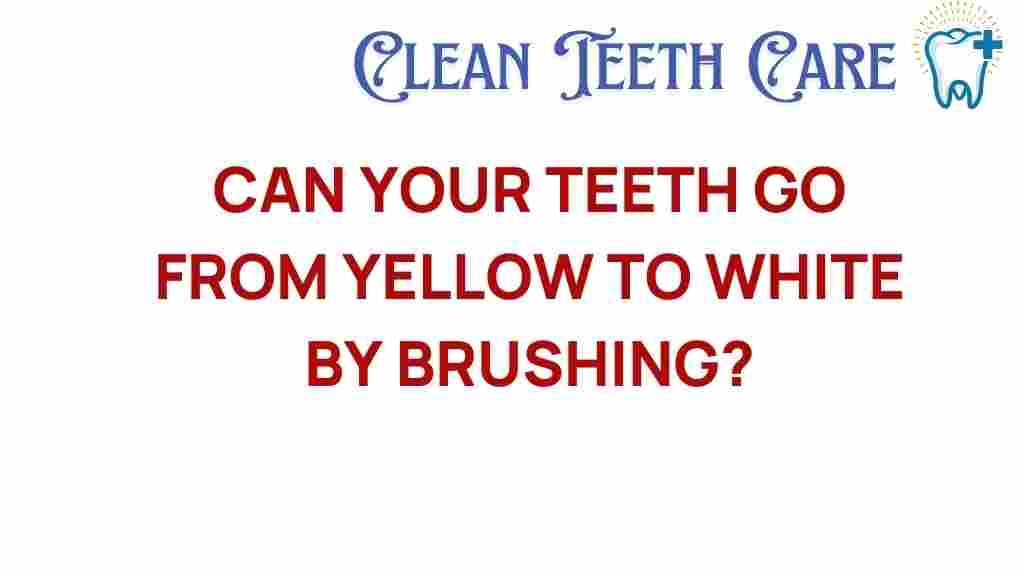Can Simple Brushing Transform Your Teeth from Yellow to White? – Understanding Teeth Whitening
Many people dream of a bright, white smile, but with the hustle and bustle of daily life, it can be challenging to maintain optimal dental hygiene. One of the most common dental concerns is yellow teeth. While professional whitening services are available, many wonder if simple brushing techniques can truly make a difference in achieving a whiter smile. In this article, we will explore how effective brushing can be for teeth whitening, and we’ll provide you with everyday tips for enhancing your oral care.
Understanding the Causes of Yellow Teeth
Before diving into brushing techniques, it’s essential to understand what causes teeth to become yellow. The discoloration of teeth can be attributed to various factors:
- Diet: Foods and beverages such as coffee, tea, red wine, and berries can stain your teeth.
- Tobacco Use: Smoking or chewing tobacco can lead to significant discoloration.
- Age: As we age, the enamel on our teeth wears down, revealing the yellowish dentin beneath.
- Poor Dental Hygiene: Inadequate brushing and flossing can lead to plaque build-up, resulting in yellowing.
- Genetics: Some individuals may naturally have thicker or thinner enamel, impacting tooth color.
Brushing Techniques for Effective Teeth Whitening
Now that we know the causes of yellow teeth, let’s focus on effective brushing techniques for maintaining dental health and achieving a whiter smile.
Step 1: Choose the Right Toothbrush
Opt for a soft-bristle toothbrush to avoid damaging your enamel. Electric toothbrushes can also be beneficial as they provide more consistent brushing action.
Step 2: Select a Whitening Toothpaste
Use a toothpaste specifically designed for teeth whitening. These formulations often contain mild abrasives that help remove surface stains without harming your enamel.
Step 3: Brush Properly
Follow these brushing techniques:
- Angle Your Brush: Keep your toothbrush at a 45-degree angle to your gums.
- Use Gentle Circular Motions: Brush in circular motions to effectively clean the surface of your teeth.
- Don’t Rush: Spend at least two minutes brushing your teeth, ensuring you cover all areas.
- Brush Twice Daily: Aim to brush your teeth in the morning and before bed.
Step 4: Floss Daily
Flossing removes plaque and food particles between the teeth that brushing alone may miss. This step is crucial for oral care and overall dental health.
Step 5: Rinse with Mouthwash
A mouthwash that contains fluoride can help strengthen your enamel and further whiten your teeth. Look for mouthwashes that also target stain removal.
Step 6: Maintain a Healthy Diet
Avoid excessive consumption of stain-causing foods and drinks. Incorporate crunchy fruits and vegetables like apples and carrots, which can help scrub your teeth naturally.
Everyday Tips for Keeping Your Smile Bright
In addition to proper brushing techniques, consider these everyday tips to maintain a white smile:
- Stay Hydrated: Drinking water helps wash away food particles and bacteria.
- Limit Stain-Causing Beverages: If you consume coffee or tea, use a straw to minimize contact with your teeth.
- Quit Smoking: If you smoke, consider quitting to avoid further discoloration.
- Regular Dental Visits: Schedule check-ups and professional cleanings every six months for optimal dental health.
Professional Whitening: An Alternative
While brushing and maintaining dental hygiene can significantly improve the appearance of your teeth, professional whitening services may offer quicker, more dramatic results. Here are some common professional whitening options:
- In-Office Whitening: This method uses a powerful bleaching agent and can lighten teeth by several shades in a single visit.
- At-Home Kits: Dentists can provide custom trays and whitening gel for you to use at home, offering more flexibility.
- Whitening Strips: Available over-the-counter, these strips can help remove stains but may not be as effective as professional treatments.
Troubleshooting Common Issues
Even with the best brushing techniques, you may encounter some challenges. Here are a few common issues and how to address them:
Problem: Sensitivity After Whitening
If you experience sensitivity after using whitening products, consider the following:
- Switch to a toothpaste designed for sensitive teeth.
- Limit whitening treatments to avoid further sensitivity.
- Consult with your dentist for personalized advice.
Problem: Stubborn Stains
Sometimes, certain stains may not respond to brushing. Here’s what you can do:
- Consult a dental professional for a deeper clean.
- Try whitening strips or gels if you haven’t already.
- Maintain a regular brushing routine to prevent new stains.
Conclusion: The Power of Simple Brushing
While simple brushing techniques can significantly improve the whiteness of your teeth, they are most effective when combined with good dental hygiene practices and a balanced diet. For those with persistent yellow teeth, professional whitening options may be worth considering. Remember, a bright smile not only enhances your appearance but also boosts your confidence. By following the tips outlined in this article, you can embark on your smile transformation journey today.
For more tips on maintaining your dental health, check out our comprehensive guide on oral care. If you’re interested in learning more about professional whitening options, visit this resource.
This article is in the category Hygiene and created by CleanTeethCare Team
